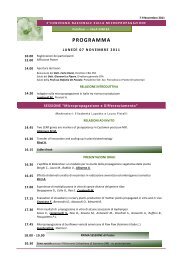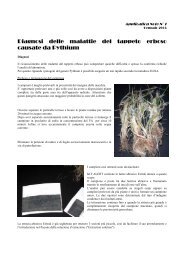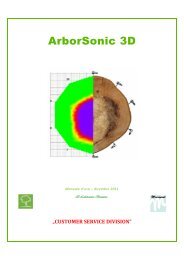BIOLOGY - microscopia.info
BIOLOGY - microscopia.info
BIOLOGY - microscopia.info
You also want an ePaper? Increase the reach of your titles
YUMPU automatically turns print PDFs into web optimized ePapers that Google loves.
130<br />
New Interactive Educational CD-ROM<br />
THE NEW LIEDER PROGRAM OF INTERACTIVE CD-ROM<br />
CD111 Human Skeleton, Musculature and Apparatus of Movement<br />
The skeleton and musculature make up the body’s support and movement apparatus. These two components<br />
work both ways: the skeleton is essential for the execution of movements and the muscles equally essential in<br />
supporting functions. The skeleton is described as the passive part of the apparatus of movement, while the<br />
muscles rank as the active part. Connective and fibrous tissue. Tendons. Cartilage. Bone cells. Haversian lamellae,<br />
interstitial lamellae. Bone tissue structure, diagram. Hollow bones. Bone marrow. The skeleton as a whole,<br />
its functional arrangement and individual parts. Skeleton, full frontal and rear views. Joints. Vertebral column.<br />
Thorax. Pectoral girdle. The limbs. Skeleton of the hand. Pelvis. Knee joint. Menisci. Skeleton of the foot. Ankle<br />
joint. The skull, front and side views. Skull dissected in its constituent bones. X-ray pictures of a bone dislocation<br />
and of a bone fracture. Full front and rear views of human musculature with twelve partial views of muscles. Fine<br />
structure of muscles. Capillary blood vessels in the muscles. The sensory and motor innervation of muscles<br />
(muscle spindles and motor end plates). Muscle efficiency. Pronation and supination muscles.<br />
CD112 Feeding Organs and Metabolism in the Human Body<br />
Proteins, carbohydrates and fats as components of our nutrition. Minerals and vitamins. Nutriment entails foodstuff<br />
intake, digestion and resorption. Health through a balanced diet. Mouth, gullet and esophagus. Tooth forms.<br />
Tooth development. Tooth renewal. Milk-teeth and permanent teeth. Cavity-causing bacteria. Salivary glands:<br />
structure, location and function. Human stomach, cardia, fundus, pylorus. Function of the gastric glands. Intestine<br />
and digestion process. Location and points of support of the digestive organs. Intestine wall layers, villi,<br />
crypts, glands, fine structure of the intestinal villus. Human large intestine (colon). Digestive enzymes as organic<br />
catalysts. Constructive metabolism (anabolism) and destructive metabolism (catabolism, conversion to energy)<br />
Function of human liver and pancreas. The liver’s glandular character and its function. Affections of the pancreas<br />
, function of islets of Langerhans. Insulin and diabetes. Function of human urinary organs: kidneys, ureter and<br />
urinary bladder. Detoxification of the body by the kidneys as a fundamental, vital process. The human body water<br />
and salt budget.<br />
CD113 The Human Respiratory and Circulatory Systems, the Human Heart<br />
The pathways through which oxygen reaches the cells varies from organism to organism. In the case of unicellular<br />
beings, oxygen diffuses directly from the environment into the cell. In the case of higher organisms, including<br />
humans, a transportation system in the body distributes oxygen taken from the environment by a specialized<br />
organ (gills, lungs). Nose and nostrils. The larynx as respiratory and voice organ. Windpipe (trachea). Lung<br />
position and structure. Alveoli. Blood irrigation. Gaseous exchange. Volume of air respired. Regulation of breathing.<br />
Lung diseases. Damage of the breathing organs caused by environmental factors. Blood as mediator between<br />
the cells in the body and the environment. Using the circulatory pathways, blood transports different<br />
substances: nutrients, respiratory gases, intermediate and end products of metabolism, active substances and<br />
substances of the immune system. Blood components. Blood groups. Blood clotting. Antibodies. Rhesus intolerance.<br />
Lymphatic system. The human immune system and its functions. Anatomy of the heart, cardiac valves,<br />
heart muscles, functions and impulses. Electrocardiogram. Blood circulation. Arteries, veins and capillaries.<br />
Regulation of blood pressure, measuring blood pressure. Exchange of substances between capillaries and<br />
tissues.<br />
CD114 Nervous System and Transmission of Information Part I<br />
Introductory CD for the nervous system. View of the entire human nervous system. Occurrence of the typical<br />
nerve cells in the human nervous system. Fine structure of a neuron, composition of the nerve, motor end<br />
plates, glial cells, nerve cells and nerve tissue. Neuron, ganglion, centers, reflex arcs, automatism. Embryonic<br />
development of the human nervous system. Neural plate, neural groove, formation and closure of the neural<br />
tube. Description of the development of different nervous systems of invertebrates and vertebrates facilitates<br />
understanding of the human nervous system. Formation of the neopallium from concentric growth rings. Phylogenetic<br />
tree of mammalian brain convolutions. Connection between brain sensory and motor nerves and various<br />
body areas. Development of the thalamus into a relay station. Progressive concentration and differentiation in<br />
the brain, component parts and their relation to each other. Increase in organizational complexity.<br />
CD115 Nervous System and Transmission of Information Part II<br />
The human central, peripheral and autonomic nervous system. Spinal cord: structure and function. Function of<br />
gray and white matter. Diagram of reflex connections. Examination of human reflexes and of diseases affecting<br />
the nervous system: polio, syphilis, sclerosis, paraplegia. Embryonic development and hierarchical structure of<br />
the brain. Structure and function of brain stem, cerebrum and cerebellum. Course of typical sensory and motor<br />
tracts. Perception, conduction and transmission of <strong>info</strong>rmation. Conscious and unconscious movement controls.<br />
The brain is simultaneously connecting and controlling organ: for that reason, <strong>info</strong>rmation perception, conduction<br />
and transmission are treated in a special section: resting potential at the axon sheath and its change.<br />
Transmission of <strong>info</strong>rmation over the synaptic gap. Types of synapse. Stimulus propagation along the axon. The<br />
brain’s blood supply: as the controlling organ of our body is the brain the biggest consumer of energy. The bloodbrain<br />
barrier. Brain stem, hindbrain and cerebellum. Brain lesions (diving accident, stroke). The autonomic nervous<br />
system, antagonistic effect between the sympathetic and parasympathetic part. Regulation of body temperature.<br />
Control of the emptying of the urinary bladder, transmitter and inhibiting substances at synapses and<br />
motor end plates.<br />
CD116 Sense Organs as a Window to the World<br />
The sense organs have the task of furnishing <strong>info</strong>rmation to the individual about himself and his environment.<br />
The ability to perceive stimuli and react to them is, together with the capacity for movement, nourishing oneself<br />
and reproducing, one of the primordial characteristics of living protoplasm. Even amoebae react to touch and<br />
light, as well as to chemical and temperature stimuli. Over the course of evolution, first some individual cells and<br />
then complex organ systems specialized in perceiving and processing stimuli. The nature of light. Eye and retina<br />
structure. Accommodation and adaptation. Image formation, movement vision, spatial vision (depth perception).<br />
Connection mechanisms in the retina and the brain. The physiological-psychological components of visual perception.<br />
Ocular affections. Optical illusions. Color vision and color blindness. Colors and psyche. Ear and hearing.<br />
Formation of sound waves. Development and structure of the human ear. Middle ear, inner ear, cochlea,<br />
organ of Corti. Directional hearing, hearing centers. Structure of the labyrinth, perception of rotation and spatial<br />
orientation. The chemical senses. The sense of smell. Location of the olfactory region. Nose conchas and olfactory<br />
epithelium. The sense of taste. The tongue’s tasting areas. Papilla foliata, vallate papilla and fungiform<br />
papilla, fine structure. The skin as organ of touch. touch corpuscles, warmth and cold receptors, sense of temperature<br />
and thermal receptors. Pressure receptors. Sensitivity differences caused by touch stimulation. Conscious<br />
awareness of the position and muscle movements. Muscle spindle and Golgi tendon apparatus. Processing<br />
of self-awareness <strong>info</strong>rmation.<br />
CD117 Reproduction and Sex Instruction<br />
Reproduction serves for the preservation of the species. The number of germ cells must balance losses caused<br />
by environmental factors (predators, climate, catastrophes), so that the number of reproductive individuals remains<br />
constant within certain parameters. The CD provides a vivid introduction into the biology of reproduction<br />
from unicellular organisms through to mammals, providing detailed representations of human reproduction and







